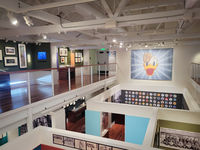Fall in with WD-FM as we explore the creation and history in our newest special exhibition, The Walt Disney Studios and World War II. Hear excerpts of interviews from Exhibition Curator Kent Ramsey, Director of Exhibitions Marina Villar Delgado, and Exhibitions Assistant Kaitlin Buickel on how they helped bring this exhibition to the public.
The Walt Disney Studios and World War II, a retrospective of The Walt Disney Studios’ extensive contributions to the Allies’ World War II effort. When Walt Disney received word that the Disney studio lot in Burbank had been requisitioned as an Army anti-aircraft base after the bombing of Pearl Harbor in 1941, he and his staff pledged to support the war effort without hesitation—and without profit. This original exhibition illustrates how the The Walt Disney Studios devoted over 90% of its wartime output to producing training, propaganda, entertainment, and public-service films, publicity and print campaigns, and over 1,200 insignia, while also deploying a group of talented artists, including Walt Disney himself, to Latin America on a Goodwill Tour.
Current Exhibitions
The Walt Disney Studios and World War II
When Walt Disney received word that the Disney studio lot in Burbank had been requisitioned as an Army anti-aircraft base after the bombing of Pearl Harbor in 1941, he and his staff pledged to support the war effort without hesitation—and without profit. This original exhibition illustrates how the The Walt Disney Studios devoted over 90% of its wartime output to producing training, propaganda, entertainment, and public-service films, publicity and print campaigns, and over 1,200 insignia, while also deploying a group of talented artists, including Walt Disney himself, to Latin America on a Goodwill Tour.
From the Store
Donald Duck Insignia Bomber Style Jacket
Exclusive for The Walt Disney Studios and World War II Special Exhibition. This bomber-style windbreaker features the museum’s exclusive insignia design of Donald Duck clad in pilot gear, holding onto the wings of a Consolidated PBY Catalina flying boat while soaring over the Golden Gate Bridge. This boat was commonly seen in the San Francisco Bay during World War II. The insignia is in multicolor embroidery with the exhibition title logo.
Donald Duck Insignia Pin Set
Exclusive for The Walt Disney Studios and World War II Special Exhibition. This two-pin set features the museum’s exclusive insignia design of Donald Duck clad in pilot gear, holding onto the wings of a Consolidated PBY Catalina flying boat while soaring over the Golden Gate Bridge. This boat was commonly seen in the San Francisco Bay during World War II. The second pin features the exhibition title logo on an army green background.
Insignia design by Mike Gabriel
Fifinella Insignia Pin Set
Exclusive for The Walt Disney Studios and World War II Special Exhibition. This two-pin set features concept art of Fifinella, created by Roald Dahl and The Walt Disney Studios and used as an insignia by the Women’s Air Force Pilots. The second pin features the exhibition title logo on an army green background.
Fifinella Insignia Track Jacket
Exclusive for Special Exhibition The Walt Disney Studios and World War II. This unisex track jacket features an exclusive design concept art of Fifinella, created by Roald Dahl and The Walt Disney Studios and used as an insignia by The Women’s Air Force Pilots, printed in a multicolor embroidery.
Related Blogs
“Disney’s Greatest Film”: Walt and Victory Through Air Power
Walt Disney had for some time been interested in making an aviation picture, and his staff had already begun research on the subject when Walt discovered Victory Through Air Power. The book, Walt explained, “helped to clarify and crystallize my convictions, and I felt that the facts of air power contained in this book should reach far beyond the limited audience of the book-reading public.”1
"Over There": Walt Disney's World War I Adventure
Starting to dabble in the entertainment industry, Walt and his friend Russell Maas put a down-payment on a movie camera and intended to begin making children’s films. The war bug, however, had also taken hold of Walt. Two of his older brothers were already in the armed forces; Ray had been drafted in the Army, and Roy was an enlistee in the Navy. During one of Roy’s visits to Chicago from his Great Lakes posting, Walt met him at the train station and remarked later that his brother "looked swell in that sailor’s uniform.” This was very appealing to young Walt, who loved costumes his entire life, and had already been in uniform himself as a high school cadet, postman, gateman, and train “butcher”. Further, Roy’s letters were full of “blowing bugles and ...patriotism,” Walt remembered. “I just had to get in there.”
Walt and the Goodwill Tour
In 1940, a newly-formed government post known as the Coordinator of Inter-American Affairs (CIAA) began asking prominent members of Hollywood to visit various countries in Latin America and/or infuse Latin American themes into their films, as part of the Good Neighbor Program. The intent was, as Nazi influence began to creep its way into South America, to generate goodwill between the Americas. Most of the goodwill attempts had fallen flat, however, some going so poorly that they actually produced the opposite result. By spring of 1941, South America had already had its fill of U.S. ambassadors’ half-hearted attempts at garnering favor.
The U.S. government then called upon Walt Disney.




